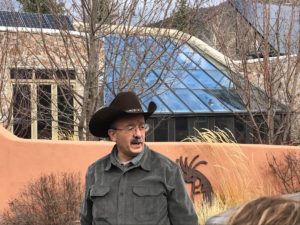In This Issue
-
Flanigan’s Eco-Logic: Dinner with Amory
- America’s First Big Offshore Wind Project
- Microgrids 1.6: Giving Batteries a Day Job!
-
Ford’s Radical EV: The Lightning
- Montreal Hosts the World’s Largest Rooftop Farm
-
Filtering Air and Oceans
-
Regional Wind Diversity
- The NetPositive Updates

Flanigan’s Eco-Logic: Dinner with Amory
Just back from ten days in the mountains of Colorado, the Roaring Fork Valley to be more specific… Old Snowmass to be precise. Actually, that’s Snowmass, but the locals throw in the “Old” so it’s not confused with Snowmass Village, the ski area resort complex.
My first night, daughters Sierra and Skye organized a mini-reunion of my Rocky Mountain Institute colleagues from the late 1980s… Lovins, Sardinsky, and Heede. Others too like Munk and Childs. Perfect temperature on the deck… the magnificence of spring in the Rockies.
Dinner two nights later, Amory, myself, and Sierra and Skye. They’ve known Amory since they were born. Off to Café Bernard in Basalt. Judy was out of town and Amory was hungry. We think the meal really fulfilled him! Between calamari and our entrees and dessert, we had more of a chance to reminisce and catch up on Amory’s consulting, RMI happenings, and new developments in the valley. At one point, Amory turned to me and pointing to my jacket said, “What does EcoMotion do?” I replied:
“Once upon a time, not too, too long ago, there was a very curious man… a high primate you would say. He charted a distinctly different utility approach and formed a movement that ultimately transformed the electric utility industry worldwide. Instead of building more and more coal plants, clearly polluting, why not try to use less plants.” Back then, Amory described that nuclear fission was like cutting butter with a chainsaw. Overkill. He thought, why not try a different approach? He called it the soft energy path… the road not taken.
“Where did this come from?” This vision. Amory explained that you don’t always have to add. You can subtract. That’s true for power plants and a good deal of engineering. The soft energy path is based on energy efficiency, subtracting from the gross load utilities have been obligated to serve. And it’s easier to subtract than to add, it just comes in smaller chunks! Efficiency is the art of using precise amounts of energy to get the job done. And now the net can be generated with renewable power, distributed throughout our society in benign configurations.
The curious man’s energy philosophy was published in the Journal of Foreign Affairs. Soon thereafter, the very curious and unquestionably smart man developed a following. I was part of it. He went to the White House to explain the soft path to President Jimmy Carter. He married a dynamo… literally and figuratively a Hunter. He wore a cowboy hat, but never seemed much like a cowboy. Instead of wrangling cattle, he created a generation of energy wonks who followed his teachings. He created a think tank high in the Rockies. Some alumni became lighting designers; others installed solar panels. One glommed on to biophilic design; others a lifetime of carbon accounting and policy designs.
Another night, I have dinner with the general manager of Holy Cross Energy (HCE), his board chair, and chief engineer. HCE is the local cooperative. Bryan Hanegan explained his utility’s progressive stance, its penchant for local distributed resources, his strategy for partnerships with his customers for generation and storage. HCE is now 50% green and on a path to net zero. His Chief Engineer, Chris Bildy, had a sparkle in his eye, working to answer my questions about hooking up mobile generators and vehicle-to-grid configurations. Chris was concise and targeted: “It’s all about interconnection.” HCE will work hard to make interconnection easy for its members. Refreshing.
While California utilities limit onsite solar production to site usage, HCE pays 10 cents per kilowatt-hour – more than double the California rate for overproduction – to encourage net positive homes. This is part of the new age utility that Amory envisioned. HCE is welcoming distributed generation, relying on it, in fact. By the end of the evening, I’d signed up for two Tesla Power Walls at our Snowmass home. Their first priority is cycling as orchestrated by Holy Cross, but in the event of an outage… the stored energy is all mine!
Amory’s early calling card in the electric utility industry was the term “negawatts.” These are the watts you don’t need thanks to energy efficiency (technologies) and conservation (behaviors). Over dinner, Amory was talking about electric aviation, and generating 8x efficiency gains doing so. He’s consulting for revolutionary car companies. He inspired me with his powerful notions of “nega-steel” and “nega-concrete.” By designing lighter buildings, you need lots less steel and cement, finding a win-win-win between structural integrity, cost savings, and environmental savings.
Spending time with my energy guru, absorbing Amory’s talk about innovative technologies, was our great pleasure. He is a treasure in wit and energy. That night, he again gave us a sense of rational possibilities ahead. He makes thinking out of the box seem only logical! One thing is for sure, the curious man in the mountains has not lost an ounce of his curiosity. Good news, that is the root of his visions.


 This sixth article on microgrids works an angle: The idea is to give expensive batteries a day job so that they earn their keep, so that they earn revenues. Solar earns money… so should batteries. Right?
This sixth article on microgrids works an angle: The idea is to give expensive batteries a day job so that they earn their keep, so that they earn revenues. Solar earns money… so should batteries. Right?
 A massive greenhouse atop a Montreal warehouse is now growing eggplants and tomatoes. It’s meeting the demand for locally sourced foods in the heart of Canada’s second largest city, Montreal.
A massive greenhouse atop a Montreal warehouse is now growing eggplants and tomatoes. It’s meeting the demand for locally sourced foods in the heart of Canada’s second largest city, Montreal. Off the coast of Iceland, Hecate Wind is in a joint venture with Independent Power Corporation, a U.K. based global power plant developer. The Hecate Independent Power (HIP) $30 billion project will involve fixed and floating wind turbines near Iceland, and then a subsea transmission line that will feed the United Kingdom, some 850 miles away. By doing so, the U.K. will have geographical diversity for its wind supply, currently with major fields in the North and Irish Seas, and soon far away near Iceland. This will protect the U.K. power system from relying too much on wind capacity from any one region.
Off the coast of Iceland, Hecate Wind is in a joint venture with Independent Power Corporation, a U.K. based global power plant developer. The Hecate Independent Power (HIP) $30 billion project will involve fixed and floating wind turbines near Iceland, and then a subsea transmission line that will feed the United Kingdom, some 850 miles away. By doing so, the U.K. will have geographical diversity for its wind supply, currently with major fields in the North and Irish Seas, and soon far away near Iceland. This will protect the U.K. power system from relying too much on wind capacity from any one region. Recently Released:
Recently Released: